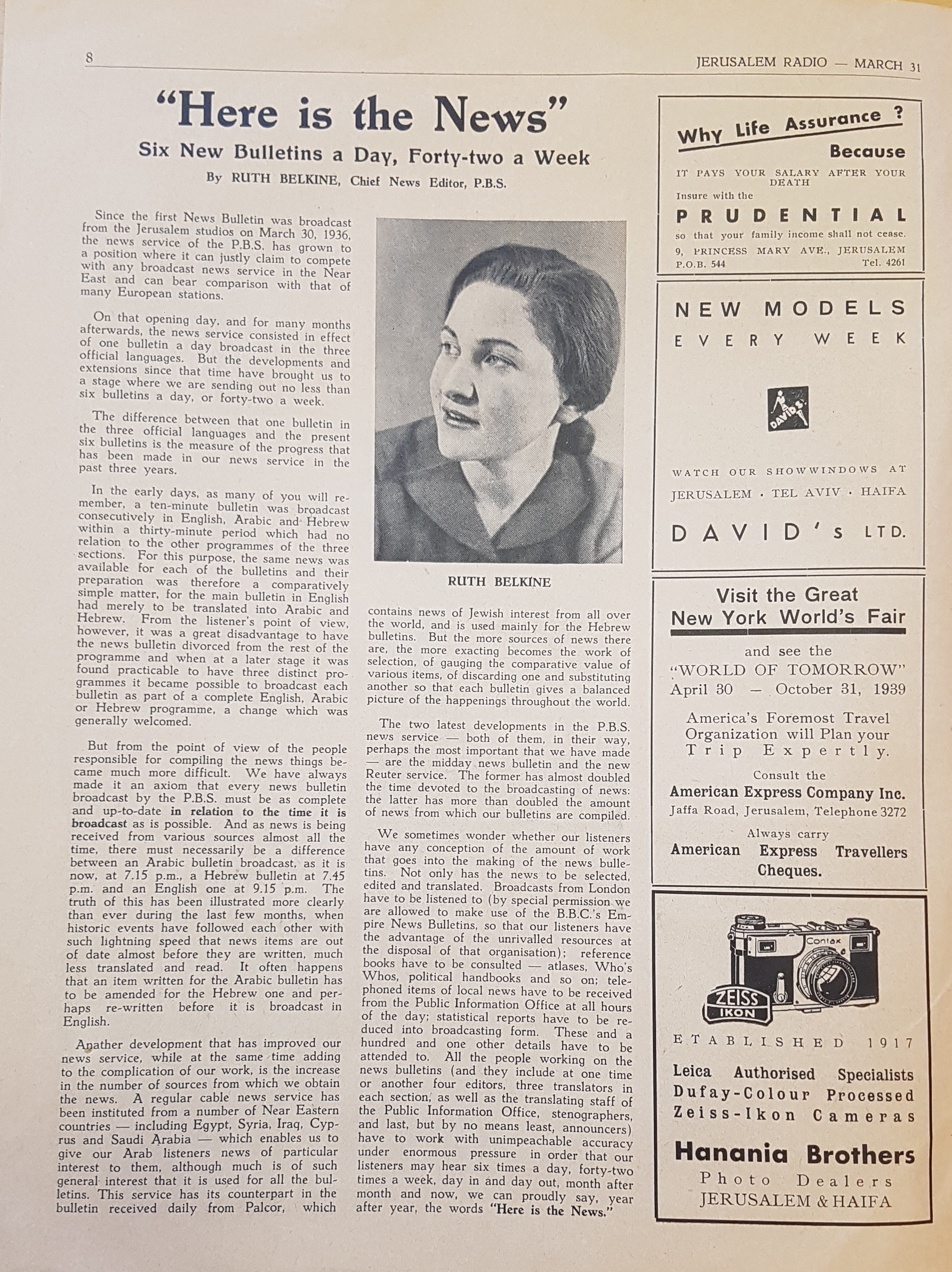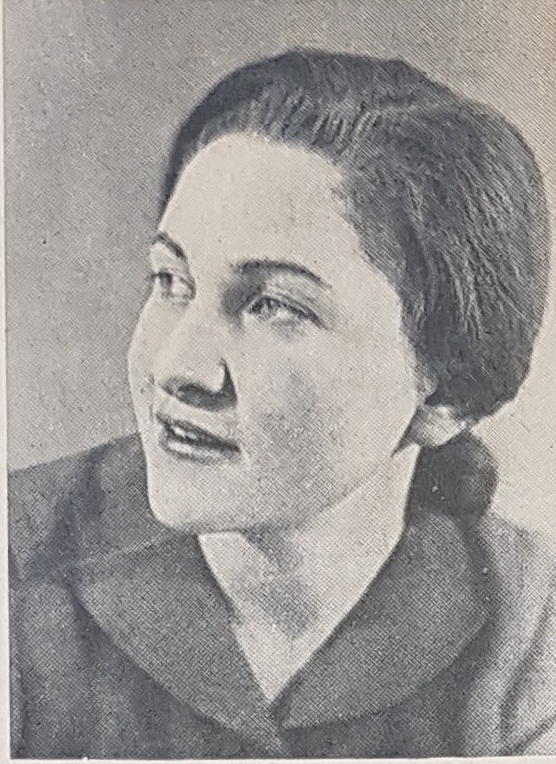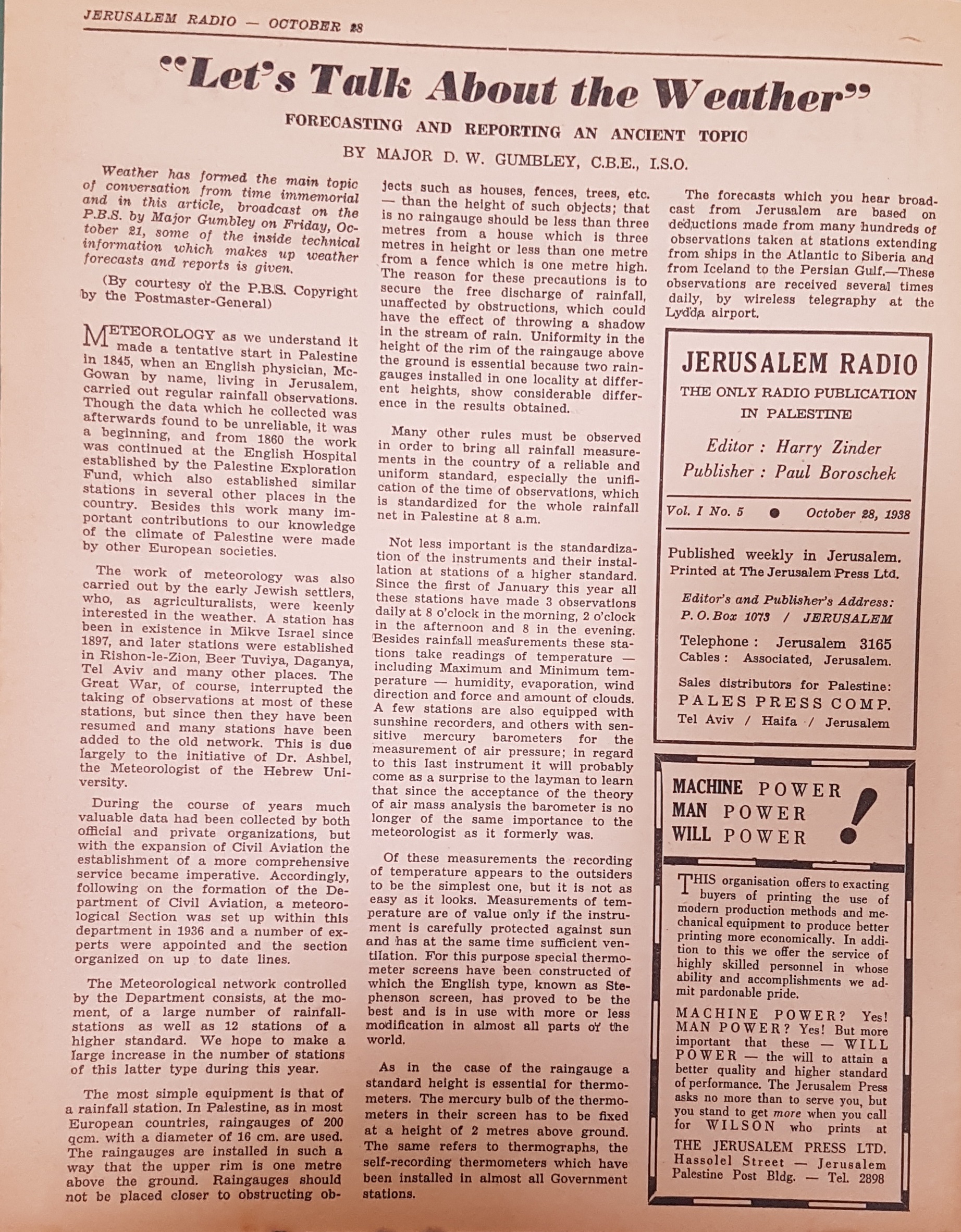Digitizing History: Palestine Broadcasting Service, 1936-1948
News and Weather

|
|||
|
Let's Talk About the WeatherFORECASTING AND REPORTING AN ANCIENT TOPIC BY MAJOR D. W. GUMBLEY, C.B.E., I.S.O.Weather has formed the main topic of conversation from time immemorial and in this article, broadcast on the P.B.S. by Major Gumbley on Friday, October 21, some of the inside technical infcmnation, which makes up weather forecasts and reports is given. (By courtesy of the P.B.S. Copyright by the Postmaster-General) METEOROLOGY as we understand It made a tentative start in Palestine in 1845, when an English physician, McGowan by name, living in Jerusalem carried out regular rainfall observatlons. Though the data which he collected was afterwards found to be unreliable it was a beginning, and from 1860 the work was continued at the English Hospital establlshed by the Palestine Exploration Fund, which also established similar stations in several other places in the country. Besides this work many important contributions to our knowledge of the climate of Palestine were made by other European societies. The work of meteorology was also carried out by the early Jewish settlers, who, as agriculturalists, were keenly interested in the weather. A station has been in existence in Mikve Israel since 1897, and later stations were established in Rishon-le-Zion, Beer Tuviya, Daganya, Tel Aviv and many other places. The Great War, of course, interrupted the taking of observations at most of these stations, but since then they have been resumed and many stations have been added to the old network. This is due largely to the initiative of Dr. Ashbel, the Meteorologist of the Hebrew University. During the course of years much valuable data had been collected by both official and private organizations, but with the expansion of Civil Aviation the establishment of a more comprehensive service became imperative. Accordingly, following on the formation of the Department of Civil Aviation, a meteorological Section was set up within this department in 1936 and a number of experts were appointed and the section organized on up to date lines. The Meteorological network controlled by the Department consists, at the moment, of a large number of rainfallstations as well as 12 stations ot a higher standard. We hope to mak.e a large increase in the number of stations of this latter type during this year. The most simple equipment Is that of a rainfall station. In Palestine, as In most European countries, raingauges of 200 qcm. with a diameter of 16 cm. are used. The raingauges are Installed In such a way that the upper rim Is one metre above the ground. Ralngauges should not be placed closer to obstructing objects such as houses, fences, trees, etc. - than the height of such objects; that is no raingauge should be less than three metres from a house which ls three metres in height or less than one metre from a fence which is one metre high. The reason for these precautions Is to secure the free discharge of rainfall, unaffected by obstructions, which could have the effect of throwing a shadow In the stream of rain. Uniformity in the height of the rim of the raingauge above the ground is essential because two raingauges installed in one locality at differ ent heights, show considerable difference in the results obtained. Many other rules must be observed in order to bring all rainfall measurements in the country of a reliable and uniform standard, especially the unification of the time or observations, which is standardized for the whole rainfall net in Palestine at 8 a.m. Not less important is the standardization of the instruments and their installation at stations of a higher standard. Since the first of January this year [1938] all these stations have made 3 observations daily at 8 o'clock in the morning, 2 o'clock in the afternoon and 8 in the evening. Besides rainfall measurements these stations take readings of temperature - including Maximum and Minimum temperature - humidity, evaporation, wind direction and force and amount of clouds. A few stations are also equipped with sunshine recorders, and others with sensitive mercury barometers for the measurement of air pressure; in regard to this last instrument it will probably come as a surprise to the layman to learn that since the acceptance of the theory of air mass analysis the barometer is no longer of the same importance to the meteorologist as it formerly was. Of these measurements the recording of temperature appears to the outsiders to be the simplest one, but it is not as easy as it looks. Measurements of temperature are of value only if the instrument is carefully protected against sun and has at the same time sufficient ventilation. For this purpose special thermometer screens have been constructed of which the English type, known as Stephenson screen, has proved to be the best and is in use with more or less modification In almost all parts of the world. As In the case of the ralngauge a standard height Is essential for thermo meters. The mercury bulb of the thermometers In their screen has to be fixed at a height of 2 metres above ground. The same refers to thermographs, the self-recording thermometers which have been installed In almost all Government stations. The forecasts which you hear broadcast from Jerusalem are based on deductions made from many hundreds of observations taken at stations extending from ships in the Atlantic to Siberia and from Iceland to the Persian Gulf, - These observations are received several times daily, by wireless telegraphy at the Lydda airport.
|

